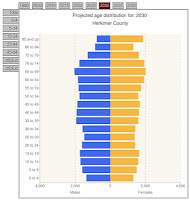Of course when we hear that the current median age for Herkimer County is 42.0 years of age, we tend to
think of that as being evenly distributed around the area. And generally speaking,
that perception is fairly accurate. However, the distribution of our population
based on age isn’t quite homogenous as one may think.
The graph below shows the median age for each of the towns
as well as the city of Little Falls in Herkimer County. Each of the municipalities is
shown with their median age (43.0, for example, for the Town of Columbia in
Herkimer County) and then a 90% confidence interval has been depicted around
that median age based on the margins of error supplied through the American
Communities Survey. So in the case of the Town of Columbia, you can see that
while the estimated median age is 43.0, we are 90% confident, based on the
sampling, that the actual figure (if we were to survey 100% of the Town) would
be between 46.3 and 39.7 years of age. Basically this is the same as saying
that the estimated median age for Columbia
is 43 years of age, +/- 3.3 years.
 |
| Click to Enlarge |
So this same process has been used to look at all of the
towns and as well as the City of Little
Falls. So what does this tell us about the
distribution of the population based on their median age then?
Well, in Herkimer
County several things
stand out. Three towns have populations that are considerably different from
the county as a whole – namely the Town of German Flatts,
the Town of Little Falls, and the Town of Webb.
German Flatts has a comparatively small confidence interval,
spanning only +/- 1.4 years. In addition, German Flatts falls significantly
below the median age of the rest of the county at 39.0 years versus the county
median age of 42.0. This would suggest that German Flatts has a statistically
younger population than the rest of the county.
In much the same way as German Flatts is younger than the
rest of the county, the Town of Little Falls is
significantly older than other parts of Herkimer County.
Again, comparing the Town’s median age of 46.7 to the County’s 42.0, even with the
Town’s median age confidence interval of +/-3 years of age, Little Falls is
statistically older than the rest of the county.
The clear outlier, however, is the Town of Webb! The median age in the Town of Webb is 57.9 years of age
– nearly 16 years higher than the counties. No other municipality even falls
within the range of its 90% confidence interval (it stretches from 52.5 years
of age to 63.3). Undoubtedly this has to do with many things unique to the
Town, including its attraction to retirees.
Here's a table that gives the median age, upper and lower bounds of the 90% confidence interval and, for each town and the City of Little Falls in Herkimer County. Note on the above graph which places over lap and which do not !
 |
| Click to Enlarge |















































